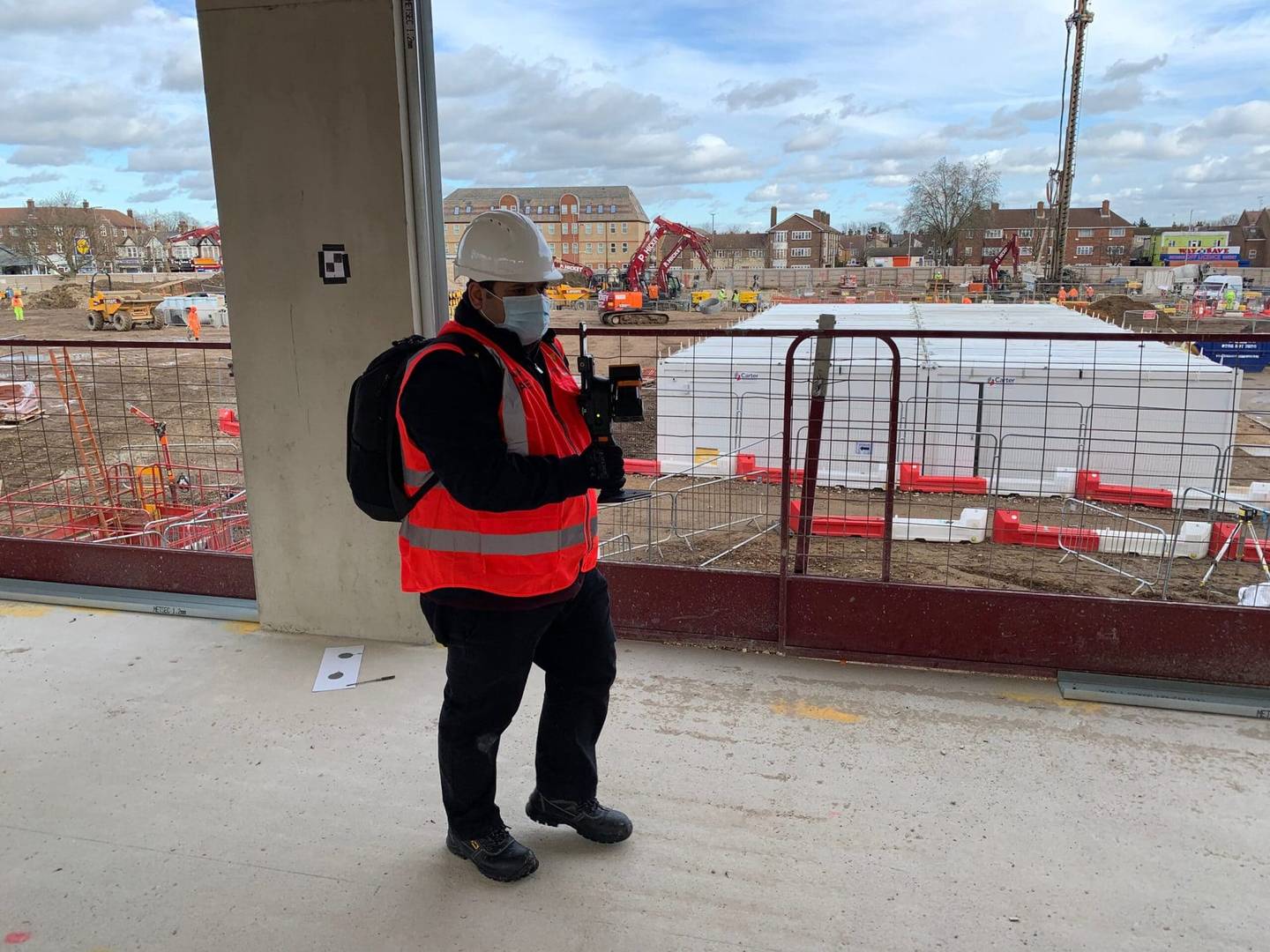The Full Value of Digital Technology in Construction
Innovation in construction gets a bad rap. This feels unfair, after all, it is a “bricks and mortar” industry, heavily reliant on equipment, machinery, and a “hands-on” workforce. Often seen as falling behind others, the embracement of technology in construction has become more prominent in recent years. Many forward-looking construction companies have deployed innovative solutions to better, and more safely, construct buildings.

But few companies have captured the full benefit of digital, and some have questioned whether they have the right approach. Piloting is one thing, getting company-wide adoption is another, and it's not hard to see why. Typically, construction projects have several hurdles to overcome, such as:
- Data, Data Everywhere
- Complex Supply-Chain
- Stuck in Analog
- Digital Isolation
Making good decisions relies on insightful data, and construction sites have a lot of it. In fact, the volume is simply staggering. However, it exists in siloed, distributed forms. There is rarely a single source of the truth.
The success of a new build relies entirely on the strength of the team, more specifically the flow of data between all stakeholders. With multiple layers of contractors and subcontractors in the project delivery supply chain and with constantly moving parts, tight collaborations are essential. Many firms struggle to operate a common data exchange.
The construction process remains one of the least digitized industries worldwide. Many processes are still manual, error-prone and have a not-so-hidden penalty cost (there's a three-in-four chance the scheduled completion date will delay by 40% or more on mega projects). Disputes, claims, fines — the risks of delays and cost overruns are a reality for many construction firms that haven't automated.
As projects vary greatly, it's hard to develop tools and methods that are repeatable. Teams or business units may develop their own subscale solution, without coordinating with others. Despite an influx of new technology providers to the sector, many offer stand-alone solutions that struggle to integrate within the wider use of technology in construction companies.
With the global population predicted to hit nine billion, and two out of every three people living in cities by 2050 — the demand for better, faster greener construction has never been greater. Could digital technologies, well-chosen and well-deployed, provide the key?
BIM Is the Right Direction, but Isn't the Whole Answer
According to the Future of Construction, Building Information Modeling (BIM) is the centerpiece of the construction industry's digital transformation. Over the last decade, BIM awareness and adoption has grown from little more than 10% in 2011 to over 70% in 2020, and the benefits speak for themselves. NBS reports that adopters report greater predictability of building performance, price and program, as well as reduced risk and increased profitability.
Yet while BIM standards are becoming embedded, and thankfully fewer people see BIM simply as “3D modeling,” there is still work to narrow the gulf between “BIM engaged” and “BIM laggards.” Deploying cutting-edge technology is only one aspect. Having the mindset and approach to collaborate is what will really unlock the value of the tech.
“At the core of BIM success is collaboration. In fact, you can't really 'do' BIM if you don't have the entire team on board in the earliest stages.” NBS
Paving the Way to Success: Why You Need a Holistic Approach
Aside from BIM, there are several connected construction technologies that are being adopted to streamline and ease the process of constructing our built world. But given the array of new technologies on offer, where's the best place to start?
“What makes construction complex is not the complexity of the building, it's the number of people that are required to work together to make it happen.” - Nathan Wood, Executive Director, Construction Progress Coalition
While it's tempting to cherry-pick solutions that fix a particular problem, developing narrow use cases may mean missing out on the wider opportunity. However, by taking a collaboration-first approach and starting with technology that improves knowledge-sharing, smooths interactions and boosts interoperability could have significant knock-on effects to address other challenges, too.
For example, selecting tech that has the potential to integrate well with all other platforms means you're not facing digital isolation. And by putting data transparency and data collection first by choosing tools that create 3D maps, this data can, in turn, be used as the anchor for better decisions between all parties. Unlocking collaboration barriers could be the key to creating lasting value.
In “Decoding Digital Transformation in Construction,” McKinsey & Co. cites how one collaboration tool drove down rework costs for a leading contractor. The quoted example talks about the contractor's process for collecting comments on defects found onsite. Workers typically provided anecdotal, unstructured or difficult-to-act-on feedback, which resulted in unplanned rework and delays.
This radically turned around when the contractor introduced a digital app to tag defects against specific elements in the BIM model and store them in a common data environment. A simple but effective collaboration solution that on-site teams could easily adopt. It smoothed out communication plus reduced rework and improved the bottom line.
Five Ways a Collaboration-First Approach Can Transform Construction
Companies that take a collaboration-first approach put themselves in a much stronger competitive position. Not only can they get a first-mover advantage, but they can boost productivity at the same time as keeping costs down:
- Save Money
- Unify Delivery Teams
- Automate Construction
- Improve Data Integrity
- Perfect the Model Virtually
Construction has a long record of poor productivity and firms experience delays on a quarter of their projects, with nearly one-fifth of projects going over budget. But with the wide adoption of mass data collection technologies, site workers can now carry out a weekly, or even daily, as-built scan of a site which highlights any discrepancies or defects during the build. NBS research suggests that 3D modeling technology can deliver cost efficiencies (60%) and increase the speed of delivery (55%).
With multiple stakeholders engaged at various points of the project lifecycle, having “one source of the truth” such as BIM enables greater collaboration and more informed decision-making. Data is brought out of silos and there's a consolidated view of all critical information that everyone can see in real-time. This improves workflow, predictability and removes bottlenecks. Critical to this is having a mapping tool that accurately captures the data in 3D model form and provides an anchor for all data extracts.
AI-powered solutions not only automate but accelerate non-value-add tasks across teams. This helps improve site efficiency and allows site workers to expand their capabilities. For example, on-site, AI can provide real-time alerts in the event of safety violations, such as if PPE is not always used. And in the back-office, AI can easily reconcile budgets and billing by matching what happens on the ground to what's been billed.
To be able to make better decisions faster, construction professionals need to know they're confidently working with the most accurate data. A Common Data Exchange, such as the one being trailblazed by the Construction Progress Coalition will not only transform project collaboration but address the common data dilemma of getting the right info to the right people at the right time. It will also improve overall data integrity and usage, making it easier to evidence compliance.
Being able to create an exact mirror of the asset in a digital twin, means you can spot and correct irregularities before building work starts, as well as monitor and correct defects on-site. This enables clients to mitigate some of the risk, time and cost impacts of complex construction projects. IDC predicts that companies that invest in digital twin technology improve the cycle times of critical processes by 30%.
We Make It Before We Make It
Royal BAM Group has a phrase that has become synonymous with the company: “We make it before we make it.” This digital-first approach enables the company to easily visualize the construction schedule, flag any potential problems and get back on track — while saving on rework.
This type of approach, which aims to manage and share data between all key parties, is especially helpful when regenerating buildings or constructing new builds in busy cities. Aside from operating on constrained sites in busy locations (e.g., where the site footprint is the building footprint), sites are often live environments, with businesses in occupation. Staging construction offsite, or “just-in-time” construction, enables all stakeholders to virtually test the stress factors and tolerances of an asset in multiple ways before the asset is built.
The Key to Unlocking Value in Construction
Like many industries, the future of construction is firmly rooted in leveraging the benefits of digital technology to deliver better outcomes. While building sites will always be an organized chaos of physical, tangible assets, there's still a huge opportunity for technology to transform the way buildings are constructed. But if you're not getting the full value from digital technology alone, don't give up. There is a better way.
Given the history of fragmentation and siloed working in construction, it follows that any, and every, digital innovation should seek to address this traditional way of working. And in doing so, it will not only be a single-use case but will have ripple effects across the whole value chain. Now really is the time to double down on digital efforts — collaboratively, of course.
References:
Reinventing construction through a productivity revolution | McKinsey
McKinsey Global Institute: Reinventing Construction – A Route to Higher Productivity
Top 4 Challenges Facing the Construction Industry – Future of Construction
An Action Plan to Accelerate Building Information Modeling (BIM) Adoption – Future of Construction
NBS' 10th National BIM Report | NBS (thenbs.com)
Decoding digital transformation in construction | McKinsey
Smart Market Report – Mitigation of Risk in Construction
NBS – National BIM Report 2019
Innovation Enterprise: Guide to Digital Twin Technology
